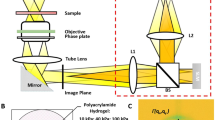Abstract
In order to protrude within a dense tissue, tumor cells have to develop the ability to digest the extracellular matrix (ECM). Melanoma cells, similarly to other types of tumor cells, form invadopodia, membranous invaginations rich in filamentous actin and several other proteins including matrix metalloproteinases (MMPs). MMPs degrade ECM structural proteins such as collagens, fibronectin, or laminin. Here we describe an assay that allows the detection of gelatinase activity exhibited by tumor cells under 2D conditions and methods to present obtained data in both a quantitative and a qualitative manner.
Access this chapter
Tax calculation will be finalised at checkout
Purchases are for personal use only
Similar content being viewed by others
References
Miller AJ, Mihm MC (2006) Melanoma. N Engl J Med 355:51–65. https://doi.org/10.1056/NEJMra052166
Sibony-Benyamini H, Gil-Henn H (2012) Invadopodia: the leading force. Eur J Cell Biol 91:896–901. https://doi.org/10.1016/j.ejcb.2012.04.001
Quintero-Fabián S, Arreola R, Becerril-Villanueva E et al (2019) Role of matrix metalloproteinases in angiogenesis and cancer. Front Oncol 9:1370. https://doi.org/10.3389/fonc.2019.01370
Bastian A, Nichita L, Zurac S (2017) Matrix metalloproteinases in melanoma with and without regression. In: Travascio F (ed) The role of matrix metalloproteinase in human body pathologies. IntechOpen, London
Breitkreutz D, Koxholt I, Thiemann K, Nischt R (2013) Skin basement membrane: the foundation of epidermal integrity-BM functions and diverse roles of bridging molecules nidogen and perlecan. Biomed Res Int 2013:179784. https://doi.org/10.1155/2013/179784
Galis ZS, Sukhova GK, Libby P (1995) Microscopic localization of active proteases by in situ zymography: detection of matrix metalloproteinase activity in vascular tissue. FASEB J 9:974–980. https://doi.org/10.1096/fasebj.9.10.7615167
Artym VV, Zhang Y, Seillier-Moiseiwitsch F et al (2006) Dynamic interactions of cortactin and membrane type 1 matrix metalloproteinase at invadopodia: defining the stages of invadopodia formation and function. Cancer Res 66:3034–3043. https://doi.org/10.1158/0008-5472.CAN-05-2177
Forastieri H, Ingham KC (1983) Fluid-phase interaction between human plasma fibronectin and gelatin determined by fluorescence polarization assay. Arch Biochem Biophys 227:358–366. https://doi.org/10.1016/0003-9861(83)90464-2
Lu ML, McCarron RJ, Jacobson BS (1992) Initiation of HeLa cell adhesion to collagen is dependent upon collagen receptor upregulation, segregation to the basal plasma membrane, clustering and binding to the cytoskeleton. J Cell Sci 101:873–883
Makowiecka A, Simiczyjew A, Nowak D, Mazur AJ (2016) Varying effects of EGF, HGF and TGFβ on formation of invadopodia and invasiveness of melanoma cell lines of different origin. Eur J Histochem 60:2728. https://doi.org/10.4081/ejh.2016.2728
Pietraszek-Gremplewicz K, Simiczyjew A, Dratkiewicz E et al (2019) Expression level of EGFR and MET receptors regulates invasiveness of melanoma cells. J Cell Mol Med 23:8453–8463. https://doi.org/10.1111/jcmm.14730
Dratkiewicz E, Simiczyjew A, Pietraszek-Gremplewicz K et al (2019) Characterization of melanoma cell lines resistant to vemurafenib and evaluation of their responsiveness to EGFR- and MET-inhibitor treatment. Int J Mol Sci 21:113. https://doi.org/10.3390/ijms21010113
Malek N, Mrówczyńska E, Michrowska A et al (2020) Knockout of ACTB and ACTG1 with CRISPR/Cas9(D10A) technique shows that non-muscle β and γ actin are not equal in relation to human melanoma cells’ motility and focal adhesion formation. Int J Mol Sci 21:2746. https://doi.org/10.3390/ijms21082746
Simiczyjew A, Pietraszek-Gremplewicz K, Dratkiewicz E et al (2019) Combination of selected MET and EGFR inhibitors decreases melanoma cells’ invasive abilities. Front Pharmacol 10:1116. https://doi.org/10.3389/fphar.2019.01116
Simiczyjew A, Mazur AJ, Ampe C et al (2015) Active invadopodia of mesenchymally migrating cancer cells contain both β and γ cytoplasmic actin isoforms. Exp Cell Res 339:206–219. https://doi.org/10.1016/j.yexcr.2015.11.003
Simiczyjew A, Dratkiewicz E, Van Troys M et al (2018) Combination of EGFR inhibitor lapatinib and MET inhibitor foretinib inhibits migration of triple negative breast cancer cell lines. Cancers 10:335. https://doi.org/10.3390/cancers10090335
Podgórska M, Pietraszek-Gremplewicz K, Nowak D (2018) Apelin effects migration and invasion abilities of colon cancer cells. Cells 7:113. https://doi.org/10.3390/cells7080113
Branch KM, Hoshino D, Weaver AM (2012) Adhesion rings surround invadopodia and promote maturation. Biol Open 1:711–722. https://doi.org/10.1242/bio.20121867
Enderling H, Alexander NR, Clark ES et al (2008) Dependence of invadopodia function on collagen fiber spacing and cross-linking: computational modeling and experimental evidence. Biophys J 95:2203–2218. https://doi.org/10.1529/biophysj.108.133199
Schindelin J, Arganda-Carreras I, Frise E et al (2012) Fiji: an open-source platform for biological-image analysis. Nat Methods 9:676–682. https://doi.org/10.1038/nmeth.2019
Díaz B (2013) Invadopodia detection and gelatin degradation assay. Bio Protoc 3:e997. https://doi.org/10.21769/BioProtoc.997
Schoumacher M, Louvard D, Vignjevic D (2011) Cytoskeleton networks in basement membrane transmigration. Eur J Cell Biol 90:93–99. https://doi.org/10.1016/j.ejcb.2010.05.010
Acknowledgments
This research was funded by National Science Centre, Poland, grant numbers 2015/17/B/NZ3/03604 (Opus 9, granted to A.J.M.) and 2016/22/E/NZ3/00654 (Sonata Bis 6, granted to A.J.M.).
Author information
Authors and Affiliations
Corresponding author
Editor information
Editors and Affiliations
Rights and permissions
Copyright information
© 2021 Springer Science+Business Media, LLC, part of Springer Nature
About this protocol
Cite this protocol
Mazurkiewicz, E., Mrówczyńska, E., Simiczyjew, A., Nowak, D., Mazur, A.J. (2021). A Fluorescent Gelatin Degradation Assay to Study Melanoma Breakdown of Extracellular Matrix. In: Hargadon, K.M. (eds) Melanoma. Methods in Molecular Biology, vol 2265. Humana, New York, NY. https://doi.org/10.1007/978-1-0716-1205-7_3
Download citation
DOI: https://doi.org/10.1007/978-1-0716-1205-7_3
Published:
Publisher Name: Humana, New York, NY
Print ISBN: 978-1-0716-1204-0
Online ISBN: 978-1-0716-1205-7
eBook Packages: Springer Protocols




